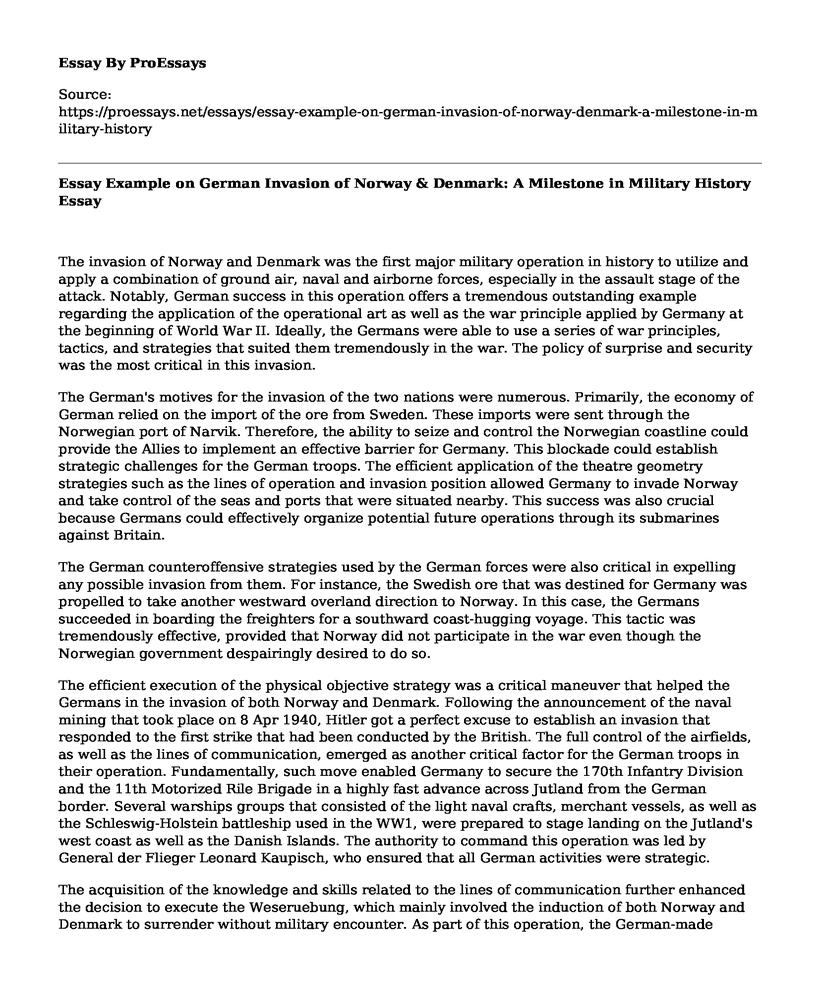The invasion of Norway and Denmark was the first major military operation in history to utilize and apply a combination of ground air, naval and airborne forces, especially in the assault stage of the attack. Notably, German success in this operation offers a tremendous outstanding example regarding the application of the operational art as well as the war principle applied by Germany at the beginning of World War II. Ideally, the Germans were able to use a series of war principles, tactics, and strategies that suited them tremendously in the war. The policy of surprise and security was the most critical in this invasion.
The German's motives for the invasion of the two nations were numerous. Primarily, the economy of German relied on the import of the ore from Sweden. These imports were sent through the Norwegian port of Narvik. Therefore, the ability to seize and control the Norwegian coastline could provide the Allies to implement an effective barrier for Germany. This blockade could establish strategic challenges for the German troops. The efficient application of the theatre geometry strategies such as the lines of operation and invasion position allowed Germany to invade Norway and take control of the seas and ports that were situated nearby. This success was also crucial because Germans could effectively organize potential future operations through its submarines against Britain.
The German counteroffensive strategies used by the German forces were also critical in expelling any possible invasion from them. For instance, the Swedish ore that was destined for Germany was propelled to take another westward overland direction to Norway. In this case, the Germans succeeded in boarding the freighters for a southward coast-hugging voyage. This tactic was tremendously effective, provided that Norway did not participate in the war even though the Norwegian government despairingly desired to do so.
The efficient execution of the physical objective strategy was a critical maneuver that helped the Germans in the invasion of both Norway and Denmark. Following the announcement of the naval mining that took place on 8 Apr 1940, Hitler got a perfect excuse to establish an invasion that responded to the first strike that had been conducted by the British. The full control of the airfields, as well as the lines of communication, emerged as another critical factor for the German troops in their operation. Fundamentally, such move enabled Germany to secure the 170th Infantry Division and the 11th Motorized Rile Brigade in a highly fast advance across Jutland from the German border. Several warships groups that consisted of the light naval crafts, merchant vessels, as well as the Schleswig-Holstein battleship used in the WW1, were prepared to stage landing on the Jutland's west coast as well as the Danish Islands. The authority to command this operation was led by General der Flieger Leonard Kaupisch, who ensured that all German activities were strategic.
The acquisition of the knowledge and skills related to the lines of communication further enhanced the decision to execute the Weseruebung, which mainly involved the induction of both Norway and Denmark to surrender without military encounter. As part of this operation, the German-made numerous special consideration and negotiations with both the governments at the time of landing. The German officials based in Oslo and Copenhagen were the official Plenipotentiaries of the German Reich. From time to time, they were tasked with presenting the German demands. Accepting such demands would further keep both the German and Danish governments under surveillance. Ideally, continuous reconnaissance was valuable in providing the German ministers in different strategic regions with insightful information on the missions and operations until the nights before landings. The use of unique codes were vital in linking Norway and Denmark to the headquarters and the landing troops about the negotiation outcomes.
Conclusion
To return to its more substantial ground of significant achievements, Weseruebung offered German numerous strategic and economic advantages in its attempt to control its supply for the Swedish ore. German also benefitted from new naval and air bases. These naval and air bases significantly improved the German position concerning the British rule and enhanced its opportunities to break out into the Atlantic with raiders. Undeniably, it was thus possible to launch colossal air and sea attacks on the Allied Murmansk convoys. It is, however, critical to note that a pivotal improvement, specifically in the naval situation, was not accomplished. Regarding this, Germany could still be barred and restricted from the open sea. The specific naval advantages attained in the bases were offset through losses in the ships sustained during Weseruebung.
Cite this page
Essay Example on German Invasion of Norway & Denmark: A Milestone in Military History. (2023, Jun 19). Retrieved from https://proessays.net/essays/essay-example-on-german-invasion-of-norway-denmark-a-milestone-in-military-history
If you are the original author of this essay and no longer wish to have it published on the ProEssays website, please click below to request its removal:
- Relevance of Ghosts of Abu Ghraib with Respect to the Military Police and Interrogators Who Participated
- Dear America: Letters Home From Vietnam
- A Sociological Analysis of the Roles of Institutions in Slavery to Make It Function
- Essay Sample on Structural Realism After the Cold War
- America Advancement in Technology Influences Them to Colonize Other Countries Essay
- 1960s Unrest Repeats Itself: Protests, Wars, Turmoil Today - Essay Example
- Martin Luther King Jr.'s Letter From Birmingham Jail - Free Essay Sample







